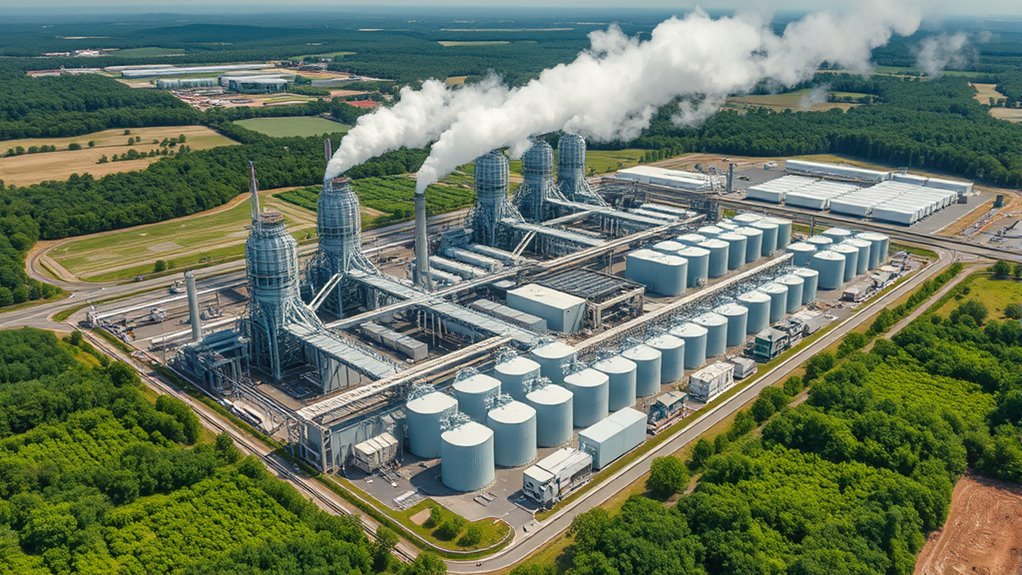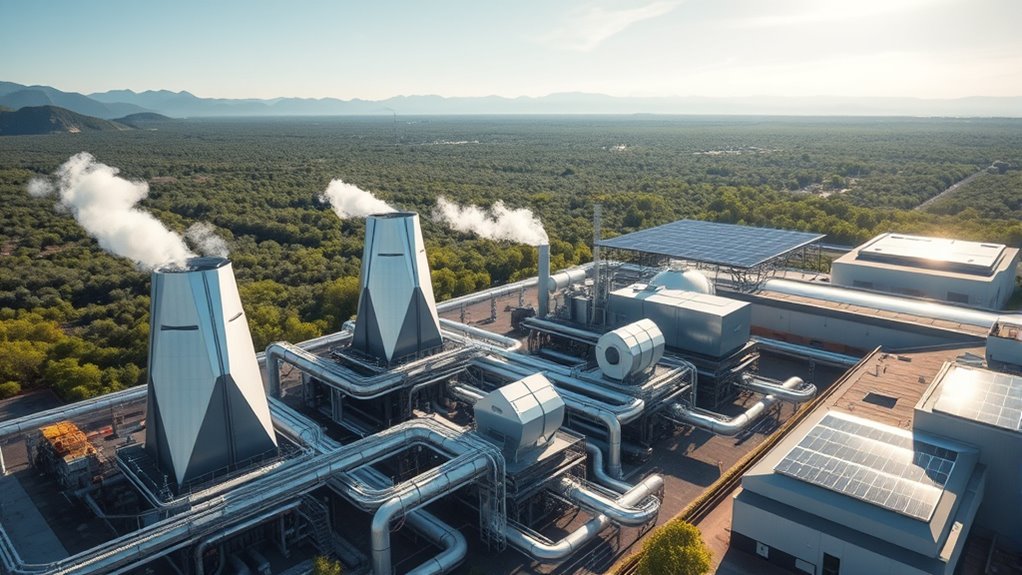A groundbreaking carbon capture plant opens, using innovative technology to remove CO2 directly from the atmosphere at an unprecedented scale. Unlike traditional methods that target factory emissions, this plant targets diffuse air sources, making a big leap toward environmental mitigation. It employs advanced sorbents and filtration systems for continuous removal, helping slow climate change and improve air quality. If you’re curious, you’ll discover how this breakthrough might shape future efforts to combat global warming.
Key Takeaways
- A new plant utilizes advanced sorbents and filtration systems for large-scale direct air capture of CO2.
- It targets atmospheric CO2, shifting focus from traditional emission point sources to broad environmental removal.
- The technology enables continuous, efficient removal of CO2 without disrupting existing infrastructure.
- This innovative project significantly advances climate change mitigation and supports global environmental efforts.
- It exemplifies breakthrough technology driving large-scale, proactive solutions for a sustainable future.

Have you ever wondered how we can reduce greenhouse gas emissions from industrial sources? The answer lies in groundbreaking advancements in technology innovation, and a new carbon capture plant is leading the charge. This facility isn’t just another step forward; it’s a leap toward transforming how we address climate change. By capturing carbon dioxide directly from the air at an unprecedented scale, it offers a promising solution to mitigate environmental impact.
Innovative carbon capture plants directly remove CO2 from the air, revolutionizing climate change mitigation efforts.
The core of this innovation involves cutting-edge technology designed specifically to remove CO2 efficiently and cost-effectively. Traditional methods focused on capturing emissions from factories or power plants, but this plant takes a different approach by directly pulling CO2 out of the atmosphere. This shift markedly broadens the scope of carbon removal efforts, making it possible to target even diffuse sources of greenhouse gases. The technology employs advanced sorbents and filtration systems that can operate continuously, capturing large volumes of CO2 without disrupting existing infrastructure. This development highlights the importance of innovative solutions in combating climate change.
This level of environmental impact is profound. By removing CO2 directly from the air, the plant helps to slow the accumulation of greenhouse gases in the atmosphere, a vital factor in combating global warming. It’s a proactive step that complements renewable energy initiatives, offering a way to address emissions from sectors that are hard to decarbonize. The environmental benefits extend beyond just reducing greenhouse gases; they also include improving air quality and supporting ecosystems affected by climate change.
Frequently Asked Questions
What Is the Expected Lifespan of the Carbon Capture Equipment?
You can expect the carbon capture equipment to last around 10 to 20 years, depending on its durability. Regular maintenance is essential; following a strict maintenance schedule helps extend its lifespan and keeps it operating efficiently. Keep an eye on wear and tear, and address issues promptly. Proper upkeep ensures you get the most out of your investment and maintain peak CO2 removal performance over the equipment’s lifespan.
How Much Does the Plant Cost to Operate Annually?
You’ll find that the plant’s annual operational cost is roughly $50 million, which is a key part of its cost analysis. To guarantee financial sustainability, they’ve optimized energy use and maintenance expenses. This investment supports large-scale CO2 removal and aligns with long-term environmental goals. Keeping a close eye on operational costs helps improve efficiency and guarantees the plant remains economically viable while fighting climate change effectively.
Can the Plant Adapt to Future CO2 Emission Increases?
Can you imagine if this plant could handle future CO2 increases? It’s designed with scalability challenges and technological flexibility in mind, so it can adapt to rising emissions. While initial setups are optimized now, ongoing upgrades will be necessary to meet future demands. By leveraging advanced technology, you’ll guarantee the plant remains effective as emissions grow, making it a crucial tool in combating climate change.
What Are the Environmental Impacts of the Plant’s Construction?
During construction, you might notice environmental disruption, like habitat disturbance and noise pollution, which can affect local wildlife. Construction emissions from machinery and transportation also contribute to air pollution temporarily. While these impacts are significant, they’re usually short-term and managed through regulations and best practices. Overall, the plant’s long-term environmental benefits, like reducing CO2 levels, can outweigh the temporary construction emissions and disruption you may observe.
How Does the Plant Integrate With Existing Energy Infrastructure?
Imagine plugging in your vintage radio—just like integrating this plant with the energy grid, you face integration challenges. The plant syncs with existing energy infrastructure by connecting to the local grid, ensuring steady power. It adapts to grid demands, but requires careful coordination to prevent overloads or outages. This seamless integration minimizes disruptions, helping you harness renewable energy efficiently while reducing carbon emissions at scale.
Conclusion
As you witness this new plant breathe life into our planet, imagine it as a mighty forest in metal armor, tirelessly pulling CO2 from the air. It’s like turning back the clock, giving Earth a fresh chance to heal. With each breath it takes, hope blossoms anew—showing that innovation can be the spark that ignites a cleaner, brighter future. This plant isn’t just capturing carbon; it’s capturing the possibility of a better tomorrow.








